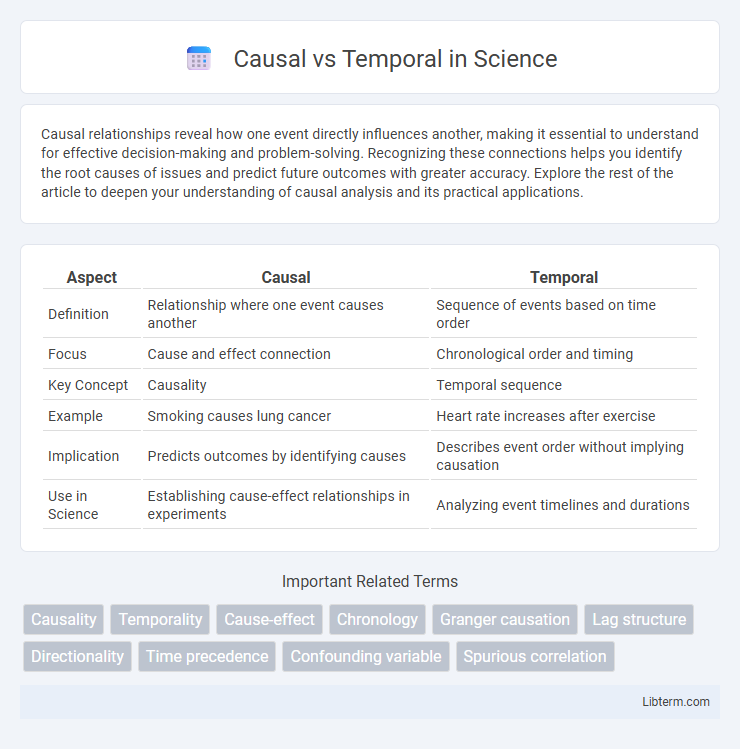Causal relationships reveal how one event directly influences another, making it essential to understand for effective decision-making and problem-solving. Recognizing these connections helps you identify the root causes of issues and predict future outcomes with greater accuracy. Explore the rest of the article to deepen your understanding of causal analysis and its practical applications.
Table of Comparison
| Aspect | Causal | Temporal |
|---|---|---|
| Definition | Relationship where one event causes another | Sequence of events based on time order |
| Focus | Cause and effect connection | Chronological order and timing |
| Key Concept | Causality | Temporal sequence |
| Example | Smoking causes lung cancer | Heart rate increases after exercise |
| Implication | Predicts outcomes by identifying causes | Describes event order without implying causation |
| Use in Science | Establishing cause-effect relationships in experiments | Analyzing event timelines and durations |
Understanding Causality: Definition and Importance
Understanding causality involves recognizing the relationship where one event directly influences the occurrence of another, which is crucial for accurate data interpretation and decision-making. Temporal relationships indicate the sequence of events but do not imply causation, making it essential to distinguish between mere chronological order and true cause-effect dynamics. Accurately identifying causal links supports scientific research, policy development, and predictive modeling across various fields.
What is Temporality? Key Concepts Explained
Temporality refers to the arrangement of events in time, emphasizing the sequence and duration rather than the cause-and-effect relationship. Key concepts include chronological order, time intervals, and the persistence of states or conditions across moments. Understanding temporality is crucial for analyzing narratives, historical data, and processes where timing impacts interpretation but does not imply direct causation.
Core Differences Between Causal and Temporal Relationships
Causal relationships involve a direct cause-and-effect link where one event or condition brings about another, establishing a dependency that explains why the effect occurs. Temporal relationships describe the sequence or timing of events without implying causation, focusing solely on the order or duration between occurrences. The core difference lies in causality requiring an explanatory connection, whereas temporality concerns only the chronological arrangement of events.
Methods for Identifying Causal Links
Methods for identifying causal links include randomized controlled trials (RCTs), which isolate causal effects by randomly assigning subjects to treatment and control groups. Structural equation modeling (SEM) and Granger causality tests analyze temporal data to infer directional relationships, distinguishing cause from mere correlation. Instrumental variable (IV) techniques and difference-in-differences (DiD) approaches leverage external variation and pre-post comparisons to address confounding factors in causal inference.
Techniques for Detecting Temporal Patterns
Techniques for detecting temporal patterns often involve time series analysis methods such as autocorrelation, Fourier transforms, and sliding window algorithms to identify periodicity and trends over time. Causal detection techniques leverage Granger causality tests and transfer entropy to determine whether one temporal event statistically influences another, distinguishing temporal correlation from actual causation. Advanced machine learning approaches, including recurrent neural networks and temporal convolutional networks, enhance pattern recognition by modeling complex temporal dependencies in sequential data.
Real-World Examples: Causal vs Temporal Scenarios
Understanding causal scenarios involves identifying direct cause-and-effect relationships, such as smoking leading to lung cancer, whereas temporal scenarios emphasize the sequence of events without implying causation, like a thunderstorm following dark clouds. In real-world applications, causal analysis helps in designing effective interventions, while temporal analysis is crucial for event prediction and timeline reconstruction. Differentiating these scenarios optimizes decision-making across fields like healthcare, meteorology, and finance by clarifying whether one event directly influences another or simply occurs in a chronological order.
Importance in Data Science and Analytics
Understanding causal relationships in data science enables accurate prediction and decision-making by identifying cause-and-effect links, which surpasses merely recognizing temporal patterns that indicate sequential order without implying causation. Causal inference techniques, such as randomized controlled trials and causal graphs, provide deeper insights into underlying mechanisms, enhancing model robustness and interpretability. Ignoring causal analysis in favor of temporal correlations risks misleading conclusions, reducing the effectiveness of analytics in real-world applications like healthcare, economics, and business strategy.
Challenges in Distinguishing Cause from Sequence
Distinguishing causal relationships from mere temporal sequences presents significant challenges due to the complexity of identifying true cause-effect links rather than coincidental event orderings. Temporal data often exhibit patterns where events follow one another without an underlying causal mechanism, leading to false inferences. Advanced methods in causal inference, such as counterfactual analysis and structural equation modeling, are essential to accurately differentiate causation from correlation in time-based datasets.
Implications for Research and Decision-Making
Distinguishing between causal and temporal relationships is critical for accurate research interpretation and informed decision-making, as causal connections imply direct influence while temporal links only indicate sequence. Misinterpreting temporal order as causality can lead to flawed conclusions and ineffective policies, highlighting the importance of robust experimental design and statistical analysis such as randomized controlled trials and Granger causality tests. Incorporating clear causal inference frameworks enhances predictive accuracy and strategic planning across disciplines including economics, healthcare, and social sciences.
Best Practices for Analyzing Causal and Temporal Data
Analyzing causal and temporal data requires distinguishing between cause-and-effect relationships and time-based sequences to avoid misinterpretation. Best practices include leveraging techniques such as Granger causality tests for temporal causality, employing controlled experiments or instrumental variables to infer true causality, and using time series analysis methods like ARIMA or VAR models to capture temporal dependencies. Ensuring data quality, temporal alignment, and robust statistical validation enhances the reliability of insights drawn from causal and temporal datasets.
Causal Infographic

 libterm.com
libterm.com